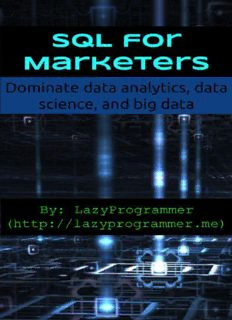
SQL for Marketers: Dominate data analytics, data science, and big data PDF
Preview SQL for Marketers: Dominate data analytics, data science, and big data
SQL for Marketers Dominate data analytics, data science, and big data By: The LazyProgrammer (http://lazyprogrammer.me) Introduction Chapter 1: Overview of SQL databases and Installing SQL Chapter 2: Relational databases and getting data Chapter 3: Basic commands Chapter 4: Speeding things up with indexes Chapter 5: Modifying a table’s data Chapter 6: Joining tables together Chapter 7: Calculations and Aggregations - Group, Sort, Limit Chapter 8: More examples - sales funnel, YOY revenue, sales by location Chapter 9: SQL on Spark Conclusion Introduction More and more companies these days are learning that they need to make DATA-DRIVEN decisions. With big data and data science on the rise, we have more data than we know what to do with. One of the basic languages of data analytics is SQL, which is used for many popular databases including MySQL, Postgres, Microsoft SQL Server, Oracle, and even big data solutions like Hive and Cassandra. I’m going to let you in on a little secret. Most high-level marketers and product managers at big tech companies know how to manipulate data to gain important insights. No longer do you have to wait around the entire day for some software engineer to answer your questions - now you can find the answers directly, by yourself, using SQL! Do you want to know how to optimize your sales funnel using SQL, look at the seasonal trends in your industry, and run a SQL query on Hadoop? Then join me now in my new book, SQL for marketers: Dominate data analytics, data science, and big data! Why marketers and product managers (PMs) need to know SQL Are you tired of depending on crufty “analytics” software? Do you have to ask an engineer to help you whenever you have a question about the data? This is not ideal and won’t help you do your job efficiently. SQL, short for “structured query language”, is a language that can be used for all kinds of databases - from the tiny databases stored in your iPhone, to large big data databases that span multiple continents. Engineers have done a great job of creating these different types of complex data stores, while still allowing you to use the same language, more or less, for all of them. What does that mean for you? It means as long as you know SQL, you can take advantage of ALL of this software, and gain insights into this data, no matter what kind of database it is stored in, as long as it supports SQL. You can ask questions like: ● How many people are falling into each stage of the sales funnel? ● What is my year over year profit? ● Are there any differences in the demographics between the people who are buying product X and product Y? ● What is our most profitable month? ● What are the seasonal trends in our industry? I’m an engineer, so I probably haven’t even thought of all the questions you’ve already had for years! But I guarantee you, knowing SQL will help you answer these questions. On various teams I’ve worked on in the tech world - I’ve noticed that marketing people and product managers have SQL skills and sometimes even coding skills! So if you are looking to not only make your day more productive, but make yourself more marketable to employers and catch up to the other go-getters in your field - then you should most definitely learn SQL. Chapter 1: Overview of SQL databases and Installing SQL Overview of SQL Databases In this section I’m going to go over a number of different technologies that use SQL. You have have already heard of MySQL. It’s very popular on the web, and if you get hosting from sites like Namecheap, it usually comes with PHP and MySQL pre-installed. Another similar database is Postgres. Postgres has made a lot of great improvements recently, one being JSON support which allows it to have a lot of functionality similar to MongoDB. MySQL and Postgres can be run on your local machine, so you can have a PHP application or a Ruby on Rails application running alongside MySQL on the same server. But you can imagine this eats up resources. So what engineers usually do at scale is to put these databases on their own servers. Now you can have multiple machines running the application code, all talking to the same database.
Description:The list of books you might like

Atomic Habits James Clear

Corrupt (Devil's Night #1)

Better Than the Movies

Can’t Hurt Me: Master Your Mind and Defy the Odds

Electrical power cable engineering

UVES - VLT High Resolution Spectroscopy of GRB Afterglows

A new genus and three new species of Lygaeoidea from New Guinea (Heteroptera, Lygaeoidea)

Caracterización de capacidades

c - Alaska District

Healthcare operations management

C: A linguagem de programação - Padrão Ansi

Electrical Engineering and Intelligent Systems

Parásitos

Shandygaff by Christopher Morley

ERIC ED427347: Road Maps To Understand School Communication.

DTIC ADA454761: Automated Discovery of Mimicry Attacks

The Life of Daniel De Foe by George Chalmers

sürdürülebilirlik raporu 2015

CA Home Health Agencies

ERIC ED362662: Training an Aging Work Force.

Corbows Theory by Lee Wallot



